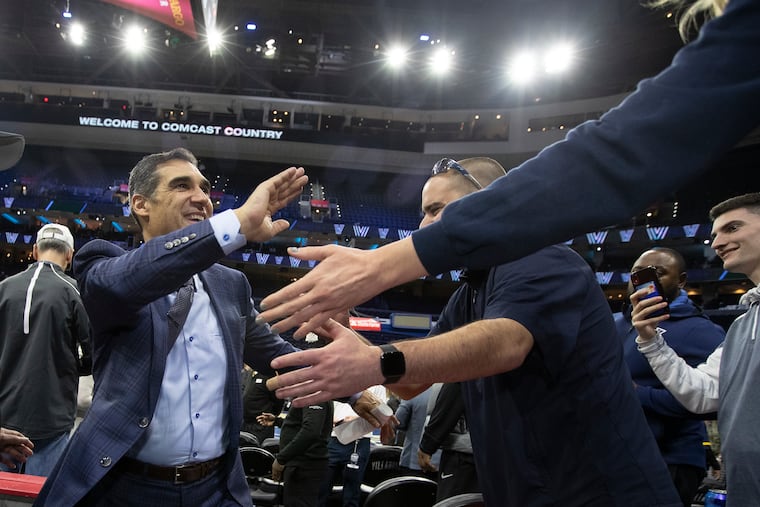Big East basketball may be ahead of the college curve looking at bubbles | Mike Jensen
By not having to worry about a league-wide football season due to COVID-19, the Big East is already looking at ways to make the 2020-21 college basketball season work.

If the Big East has earned the right to consider itself a “Power 6” league when it comes to basketball, it has had an advantage over the Power 5 in figuring out how to handle sports during the COVID-19 pandemic.
It didn’t have to deal with league-wide football.
That advantage possibly meant the Big East got a head start on hoops, and has been “more actively building out bubble scenarios,” according to a Big East administrator.
So what does that mean? Too early to tell. Just that the Big East is pricing out potential options. A central bubble? Regionalized bubbles? Say you have a bubble scenario where Villanova, Georgetown, Seton Hall, St. John’s, and Providence gather and get in as many games as they can in a short time, everybody able to get there on a bus.
Maybe you’d switch up and have another bubble at another time, switching up the teams. Or maybe Indianapolis or Omaha, Neb., could host a big bubble. Adam Zagoria reported IMG Academy in Bradenton, Fla., is on the list as a potential bubble spot, since it already hosts the WNBA.
(A Philly side note: Attempts to include a Big 5 hoop schedule will be on the table. That’s vague and preliminary but beats a “no chance” scenario. That does not mean, however, leagues are in consultation with each other in coming up with league bubble scenarios.)
Within the Big East, cost-benefit analyses are being handed around. Some timing scenarios mean starting at Thanksgiving, or over the winter break. There’s also a “super-delayed” model being offered up in which preseason training doesn’t start until January, the nonconference schedule begins in February, the Big East schedule in March. You end up with May Madness.
None of this, mind you, has hit the desks of Big East presidents. This is coaches and athletic directors, plus the league office, going back and forth, discussing men’s and women’s hoops. The presidents will ultimately decide. As we saw for football, those discussions can take dramatic turns.
The obvious was pointed out to me, that none of these decisions can be made in a vacuum, that the COVID-19 landscape will have a large say. Are campuses staying open? Will presidents feel comfortable moving their athletes around? Expect internal debates on amateurism and what can be expected of Big East athletes.
Travel costs probably won’t factor in. Big East teams already spend on travel. A bubble won’t change the expense side of the ledger dramatically. “Not a sticker-shock type scenario,” is the way it was put to me.
Unlike football, where it has been every league for itself, the NCAA will have a large say in what might be possible, simply by announcing a potential schedule, a start date, and a theoretical time frame for the NCAA Tournament. In many ways, the leagues will work back from there.
Nobody is expecting any of it to look normal. Could be a six-game league schedule, could be 14, could be anything. NCAA head of basketball Dan Gavitt has repeatedly told members, “This is not going to be fair.”
Meaning: Coaches, don’t complain about your unbalanced schedules. Be happy if games are played at all.
A lot of this, another Big East source said, will depend on what testing looks like this winter. If you’re asking athletes to cross state lines, you might have low numbers on your campus, but you need confidence that you’re not traveling into danger zones.
Television partners will weigh in, maybe even have suggestions for how big or small a potential NCAA field should be. Don’t be shocked, in other words, if there is a need for programming and the field is suddenly 128 teams. Or it could go the other way, get to 32. Will the time-honored system of automatic bids for all Division I leagues hold? It’s all to be determined.
One bottom line you hear, the NCAA will make every last effort to have its 2021 tournament, whatever the timing has to be.
“I think anything is on the table to get us to a point where kids can play,” said a Big East administrator.
So if the Big East is ahead of the game, what about the rest?
“Depends on campus activity and presidential threshold,” said a non-Big East league administrator.
Fair enough. The Big East showed back in March, when a league tournament game at Madison Square Garden was halted at halftime, that you can game out all scenarios all you want, but you better be prepared to audible.
The goal, however, is clear that wherever this pandemic takes us in the months just ahead, the Big East will have a scenario for it. A Power 6 league can afford to do that.